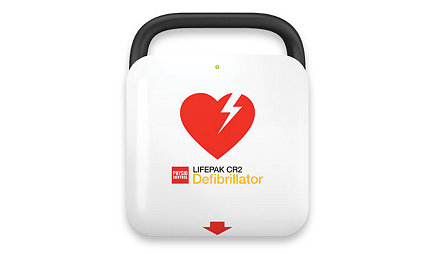Defibrillator 101
21-Nov-2025

2-minute read
Is your business prepared for sudden cardiac arrest (SCA)?
It’s an ordinary Monday morning at work. A customer nearby collapses, and in a split-second everything changes. Chaos swirls. What happens next?
SCA can strike anywhere—at the grocery store, during a game or in the office. It’s a leading cause of death in the United States and, worldwide, claims more lives than colorectal cancer, breast cancer, prostate cancer, influenza, pneumonia, auto accidents, HIV, firearms and house fires combined.1 About 357,000 out-of-hospital SCAs occur in the U.S. each year, and nearly 90% are fatal.2 The chance of survival increases up to 50-70% when an automated external defibrillator (AED) is present, which is why early defibrillation matters.3
How does a defibrillator work?
A defibrillator for cardiac arrest is designed to analyze the heart’s rhythm and, if needed, deliver an electric shock to help correct a dangerous arrhythmia and restore a normal heartbeat. In public settings, AEDs provide clear voice and visual prompts, so even untrained bystanders can begin care while help is on the way. In short, it detects, analyzes and if advised, delivers a potentially lifesaving shock—then guides you on next steps like cardiopulmonary resuscitation (CPR).
AEDs are designed for real-world use
AEDs are lightweight and portable and can be used on children, teens and adults. Electrode pads placed on the chest send information to the device, which determines whether a shock is advised. If so, the shock is delivered through the pads. The device continues to guide you—often instructing you to resume CPR—until first responders arrive. Some AEDs, like Stryker’s LIFEPAK CR2 defibrillator, deliver escalating energy when multiple shocks are needed for difficult-to-defibrillate patients.4
Why early defibrillation is critical
It’s important to know when to use a defibrillator because cardiac arrest is a race against time. Early defibrillation of the heart—paired with high-quality CPR—can help improve a person’s chances of survival before EMS arrives. Making an AED easy to find and ready to use in your workplace helps teams act fast when every second counts.
What to do if someone collapses
- Start CPR
- Ask someone to call 911 and bring the nearest AED
- Expose the chest and place pads as shown on the AED
- If the AED advises a shock, make sure no one is touching the person and press the button (or stand clear if it’s fully automatic)
- Follow the AED prompts until EMS arrives; resume CPR when instructed
Ready to help your team respond?
Together, we can help protect your workplace and community. Explore our full line of AEDs and defibrillators for cardiac arrest in public places, along with training and support resources, so your business is better prepared for SCA. Learn more.
Related
LIFEPAK CR2 defibrillator
The LIFEPAK CR2 AED response system empowers bystanders to help save lives. Innovative, easy-to-operate technology allows continuous CPR and helps streamline communication across the system of care.
Learn moreGame-changer in emergency preparedness
In a world where emergencies can strike at any moment, being prepared isn't just important—it's essential. With over 30 years of experience in both college and professional sports, Darryl Conway is committed to improving emergency response protocols. Recently, he shared his insights on the ABCDEFG method—a practical approach to handling sudden cardiac arrest.
Learn moreAED buying guide
An effective AED program is a critical link in the chain of survival, empowering you to deliver lifesaving intervention even before emergency services arrive. Stryker offers diverse options to help you choose the right defibrillator for your employees and customers.
Learn moreAED users should be trained in CPR and in the use of the AED. AEDs which are for public use/trained users can also be used by professional users.
1. Meaney, P. A., Bobrow, B. J., Mancini, M. E., Christenson, J., de Caen, A. R., Bhanji, F., Abella, B. S., Kleinman, M. E., Edelson, D. P., Berg, R. A., Aufderheide, T. P., Menon, V., & Leary, M. (2013). Cardiopulmonary resuscitation quality: Improving cardiac resuscitation outcomes both inside and outside the hospital: A consensus statement from the American Heart Association. Circulation, 128(4), 417–435. https://doi.org/10.1161/CIR.0b013e31829d8654
2. American Heart Association. (2020, October). A race against the clock: Out-of-hospital cardiac arrest [Fact sheet]. https://www.heart.org/-/media/Files/About-Us/Policy-Research/Fact-Sheets/Acute-Care/Out-of-Hospital-Cardiac-Arrest.pdf
3. Elhussain MO, Ahmed F k, Mustafa NM, Mohammed DO, Mahgoub IM, Alnaeim NA, et al. The Role of Automated External Defibrillator Use in the Out-of-Hospital Cardiac Arrest Survival Rate and Outcome: A Systematic Review. Cureus. 2023;15(10):e47721. doi:10.7759/cureus.47721.
4. Stiell I, Walker R, Nesbit L, et al. The BIPHASIC Trial: A randomized comparison of fixed lower versus escalating higher energy levels for defibrillation in out-of-hospital cardiac arrest. Circulation. 2007.
EC-LCR2-COMM-2384702_REV-0_en_us



